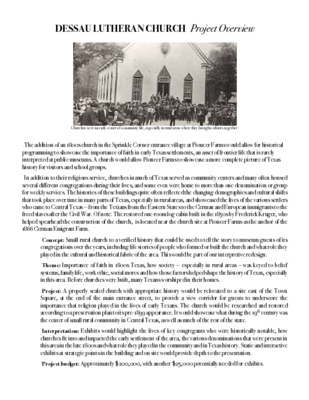B.4.4 - 13300 Dessau Rd - Project overview — original pdf
Backup

DESSAU LUTHERAN CHURCH Project Overview Churches were an early center of community life, especially in rural areas where they brought cultures together. The addition of an 1800s church in the Sprinkle Corner entrance village at Pioneer Farms would allow for historical programming to showcase the importance of faith in early Texas settlements, an asset of frontier life that is rarely interpreted at public museums. A church would allow Pioneer Farms to showcase a more complete picture of Texas history for visitors and school groups. In addition to their religious service, churches in much of Texas served as community centers and many often housed several different congregations during their lives, and some even were home to more than one denomination or group for weekly services. The histories of these buildings quite often reflected the changing demographics and cultural shifts that took place over time in many parts of Texas, especially in rural areas, and showcased the lives of the various settlers who came to Central Texas — from the Texians from the Eastern States to the German and European immigrants to the freed slaves after the Civil War. Of note: The restored one-room log cabin built in the 1850s by Frederick Kruger, who helped spearhead the construction of the church, is located near the church site at Pioneer Farms as the anchor of the 1866 German Emigrant Farm. Concept: Small rural church to a verified history that could be used to tell the story to museum guests of its congregations over the years, including life stories of people who formed or built the church and what role they played in the cultural and historical fabric of the area. This would be part of our interpretive redesign. Theme: Importance of faith in 1800s Texas, how society — especially in rural areas — was keyed to belief systems, family life, work ethic, social mores and how those factors helped shape the history of Texas, especially in this area. Before churches were built, many Texans worshiped in their homes. Project: A properly scaled church with appropriate history would be relocated to a site east of the Town Square, at the end of the main entrance street, to provide a view corridor for guests to underscore the importance that religion played in the lives of early Texans. The church would be researched and restored according to a preservation plan to its pre-1899 appearance. It would showcase what during the 19th century was the center of small rural community in Central Texas, as well as much of the rest of the state. Interpretation: Exhibits would highlight the lives of key congregants who were historically notable, how churches fit into and impacted the early settlement of the area, the various denominations that were present in this area in the late 1800s and what role they played in the community and in Texas history. Static and interactive exhibits at strategic points in the building and on site would provide depth to the presentation. Project budget: Approximately $200,000, with another $25,000 potentially needed for exhibits.